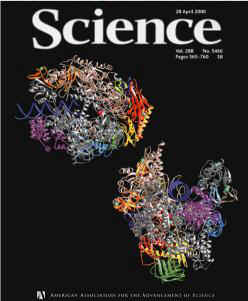
RNA Polymerase transcribes genetic
information into a message that can be read by the ribosome to produce
protein.
The research group of Professor Roger Kornberg of Stanford University
has studied the structure of this 12-subunit and half-megadalton size macromolecular
machine using diffraction data collected at SSRL.

A key step in gene expression is the "transcription" of the DNA sequences comprising the genes into messenger RNAs. Transcription is the first step and a key control point in gene expression. Transcriptional regulation underlies all aspects of cellular metabolism including oncogenesis (cancer) and morphogenesis (development). RNA polymerase II (Pol II) is a large (550 kDa) complex of 12 subunits that is at the heart of the transcription mechanism. Gene expression, and therefore RNA pol II, is regulated by a number of proteins, in particular initiation and transcription factors.
The interpretation of the structural and biochemical experiments have resulted in a number of breakthrough publications including:
http://www.sciencemag.org/cgi/content/abstract/1059495
http://www.scie
ncemag.org/cgi/content/abstract/1059493
http://www.sciencemag.org/cgi/content/abstract/288/5466/640
Jean Marx of Science Magazine (Science Apr 20 2001: 411-414) describes this remarkable structure in the following way:
"If any enzyme does the cell's heavy lifting, it's RNA polymerase II. Its job: getting the synthesis of all the proteins in higher cells under way by copying their genes into RNAs, and doing it at just the right time and in just the right amounts. As such, pol II, as the enzyme is called, is the heart of the machinery that controls everything that cells do--from differentiating into all the tissues of a developing embryo to responding to everyday stresses. Now, cell biologists can get their best look yet at just how the pol II enzyme of yeast and, by implication, of other higher organisms performs its critical role."
In two papers published online today by Science (www.sciencexpress.org), Roger Kornberg's group at Stanford University School of Medicine describes the atomic structure of the yeast enzyme; a slightly lower resolution structure captures yeast pol II in the act of transcribing a piece of DNA into RNA. Cell biologist E. Peter Geiduschek of the University of California, San Diego, describes the achievement as "extraordinary." Not only does it give cell biologists their first clear view of yeast pol II in action, but it also opens the door to seeing exactly how the enzyme interacts with the many other proteins that regulate its activity. And that, adds Geiduschek, will "transform the analysis of transcription and transcription mechanisms in a fundamental way."
Additional information can be found
on the homepages of Kornberg (http://kornberg.stanford.edu/)
and Cramer (http://www.lmb.uni-muenchen.de/cramer/)
This work has been cited in the following articles:
- Cramer, P., Bushnell, D. A., Kornberg, R. D. (2001). Structural Basis of Transcription: RNA Polymerase II at 2.8 Angstrom Resolution. Science 292: 1863-1876
- Tran, D. P., Kim, S. J., Park, N. J., Jew, T. M., Martinson, H. G. (2001). Mechanism of Poly(A) Signal Transduction to RNA Polymerase II In Vitro. Mol. Cell. Biol. 21: 7495-7508
- Chan, C. L., Gross, C. A. (2001). The Anti-initial Transcribed Sequence, a Portable Sequence that Impedes Promoter Escape, Requires sigma 70 for Function. J. Biol. Chem. 276: 38201-38209
- Langelier, M.-F., Forget, D., Rojas, A., Porlier, Y., Burton, Z. F., Coulombe, B. (2001). Structural and Functional Interactions of Transcription Factor (TF) IIA with TFIIE and TFIIF in Transcription Initiation by RNA Polymerase II. J. Biol. Chem. 276: 38652-38657
SSRL Highlights Archive
